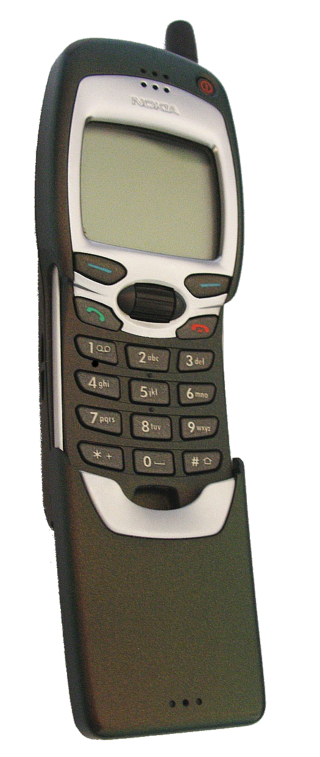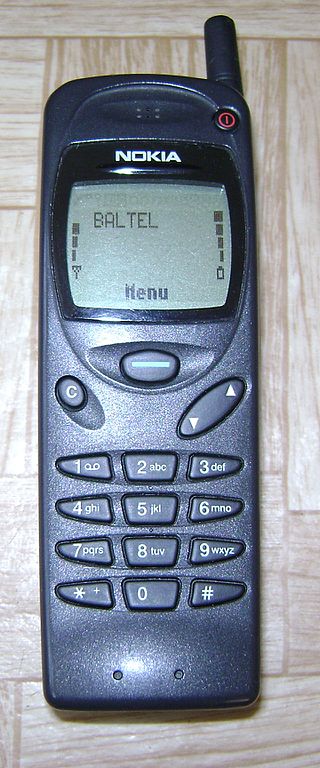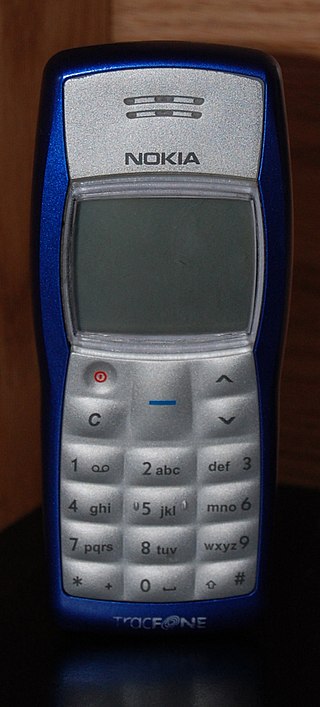
Short Message/Messaging Service, commonly abbreviated as SMS, is a text messaging service component of most telephone, Internet and mobile device systems. It uses standardized communication protocols that let mobile devices exchange short text messages. An intermediary service can facilitate a text-to-voice conversion to be sent to landlines.
The Nokia 3310 is a discontinued GSM mobile phone announced on 1 September 2000, and released in the fourth quarter of the year, replacing the popular Nokia 3210. It sold very well, being one of the most successful phones, with 126 million units sold worldwide, and being one of Nokia's most iconic devices. The phone is still widely acclaimed and has gained a cult status due to its reputation for durability.

The Nokia 7110 is a GSM mobile phone announced in February 1999 and released in October 1999. It was the first mobile phone to run Series 40 and to come with a WAP browser.

The 3110 is a GSM mobile phone handset manufactured by Nokia in Hungary, introduced at CEBIT in March 1997. The 3110 is notable as the first Nokia handset to feature the 'Navi-Key' menu navigation system. The Navi-Key was featured heavily on Nokia handsets, especially the entry-level models such as the Nokia 1100 in the following years. Unlike its successor, the 3210, and subsequent handsets of similar design, the 3110 had an external antenna. The phone was available with a slim, standard or vibrating battery. It could only be used on a GSM-900 network.

The Nokia 3210 is a GSM cellular phone, announced by Nokia on 18 March 1999.

The Nokia 1100 is a basic GSM mobile phone produced by Nokia. Over 250 million 1100s have been sold since its launch in late 2003, making it the world's best selling phone handset and the best selling consumer electronics device in the world at the time. The model was announced on 27 August 2003 and was discontinued in September 2009.
Pantech Inc. is a South Korean company that manufactures mobile phones. Established in 1991, its market is mainly domestic with partners in the United States, Japan, China, Europe and Vietnam. In 2012 Pantech was the second best-selling handset maker in South Korea, according to Gartner. In 2013 Samsung Electronics bought a 10% stake in Pantech. Pantech also partners with PCD for specialized phones.

A mobile phone feature is a capability, service, or application that a mobile phone offers to its users. Mobile phones are often referred to as feature phones, and offer basic telephony. Handsets with more advanced computing ability through the use of native code try to differentiate their own products by implementing additional functions to make them more attractive to consumers. This has led to great innovation in mobile phone development over the past 20 years.

Nokia 8210 is a mobile phone by Nokia, announced on 8 October 1999 in Paris. At the time, it was the smallest, lightest Nokia mobile phone on the market. A primary selling point of its design was its removable cover that allowed for easy customization. Six differently coloured Xpress-on covers are available, as well as many third-party ones.

The Nokia 8850 is a mobile phone handset manufactured by Nokia. It was a light alloy-bodied enhanced version of Nokia 8210 model with slider protection of the keypad and white lighting of the keypad and screen. The 8850 is considered to be an un-repairable phone, thus resulting in very few active handsets in the market. Today it remains a collector's item. It also came in gold. It was introduced as a successor of an earlier model, the chrome phone Nokia 8810.
Wireless Application Protocol (WAP) is a technical standard for accessing information over a mobile wireless network. A WAP browser is a web browser for mobile devices such as mobile phones that use the protocol. Introduced in 1999, WAP achieved some popularity in the early 2000s, but by the 2010s it had been largely superseded by more modern standards. Almost all modern handset internet browsers now fully support HTML, so they do not need to use WAP markup for web page compatibility, and therefore, most are no longer able to render and display pages written in WML, WAP's markup language.

Some mobile phones support use of two SIM cards, described as dual SIM operation. When a second SIM card is installed, the phone may allow users to switch between two separate mobile network services manually, have hardware support for keeping both connections in a "standby" state for automatic switching, or have two transceivers to maintain both network connections at once.

The SGH-F700, marketed as the Ultra Smart F700, is a smartphone manufactured by Samsung. Using Vodafone as its network provider, the phone was first introduced at the 3GSM World Congress that was held in February 2007. Sales to the European market started November 2007.

The Nokia 1011 is the first mass-produced GSM phone. It was sold also as Mobira Cityman 2000. The typenumber refers to the launch date, 10 November 1992.

The Nokia 2110 is a cellular phone made by the Finnish telecommunications firm Nokia, first announced and released in January 1994. It is the first Nokia phone with the famous Nokia tune ringtone. The phone can send and receive SMS messages; and lists ten dialed calls, ten received calls and ten missed calls. At the time of the phone's release, it was smaller than others of its price and had a bigger display, so it became very popular. It also features a "revolutionary" new user interface featuring with two dynamic softkeys, which would later lead to the development of the Navi-key on its successor, the Nokia 6110, as well as the Series 20 interface.
The Nokia 6010 is an entry-level mobile phone with a Nokia Series 40 96 × 65 color user interface.
Human Mobile Devices (HMD), also branded as Nokia Mobile and formally as HMD Global, is a Finnish mobile phone manufacturer. The company is made up of the mobile phone business that the Nokia Corporation sold to Microsoft in 2014, then bought back in 2016. HMD began marketing Nokia-branded smartphones and feature phones on 1 December 2016. The company has exclusive rights to the Nokia brand for mobile phones through a licensing agreement. The HMD brand was initially only used for corporate purposes and does not appear in advertising, whereas the name "Nokia Mobile" is used on social media. In January 2024, HMD rebranded to Human Mobile Devices, and will use their own branding on future devices alongside that of Nokia.

KaiOS is a mobile Linux distribution for keypad feature phones based on the Firefox OS open-source project. It is developed by KaiOS Technologies Limited; a company based in Hong Kong, whose largest shareholder is Chinese electronics conglomerate TCL Corporation. KaiOS runs on feature phones or wireless home phones made with low-power hardware and low power consumption. KaiOS supports modern connectivity technologies like 4G LTE E, VoLTE, GPS, and Wi-Fi. KaiOS runs HTML5-based apps. KaiOS supports over-the-air updates and has a dedicated app marketplace called KaiStore. Some applications are preloaded, including Facebook and YouTube. As of 1 April 2020, there are 500+ apps in KaiStore. The mobile operating system is comparatively lightweight on hardware resource usage, and is able to run on devices with just 256 megabytes (MB) of memory.

The Nokia 8110 4G is a Nokia-branded mobile phone developed by HMD Global. It was announced on 25 February 2018 at Mobile World Congress (MWC) 2018 in Barcelona, Spain, as a revival of the original Nokia 8110, which was popularly known as the "Matrix phone" or "banana phone". The phone is dual SIM capable even though it is limited to 2G in one slot while running both SIM cards. It runs on an operating system based on KaiOS.














